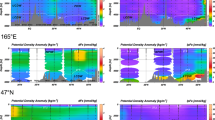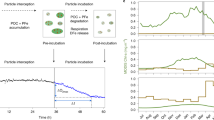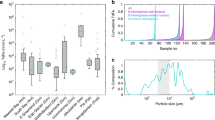Abstract
The micronutrient iron is thought to limit primary productivity in large regions of the global ocean1. Ice sheets and glaciers have been shown to deliver bioavailable iron to the coastal and open ocean in the form of sediment released from the base of icebergs2,3 and glacially derived dust4. More direct measurements from glacial runoff are limited, but iron concentrations are thought to be in the nanomolar range5. Here we present measurements of dissolved and particulate iron concentrations in glacial meltwater from the southwest margin of the Greenland ice sheet. We report micromolar concentrations of dissolved and particulate iron. Particulate iron concentrations were on average an order of magnitude higher than those of dissolved iron, and around 50% of this particulate iron was deemed to be potentially bioavailable, on the basis of experimental leaching. If our observations are scalable to the entire ice sheet, then the annual flux of dissolved and potentially bioavailable particulate iron to the North Atlantic Ocean would be approximately 0.3 Tg. This is comparable to dust-derived soluble iron inputs to the North Atlantic. We suggest that glacial runoff serves as a significant source of bioavailable iron to surrounding coastal oceans, which is likely to increase as melting of the Greenland ice sheet escalates under climate warming.
This is a preview of subscription content, access via your institution
Access options
Subscribe to this journal
Receive 12 print issues and online access
$259.00 per year
only $21.58 per issue
Buy this article
- Purchase on Springer Link
- Instant access to full article PDF
Prices may be subject to local taxes which are calculated during checkout


Similar content being viewed by others
Change history
29 April 2013
In the version of this Letter originally published, in the first sentence of the final paragraph, the 1992–2010 percentage increase in freshwater flux from the GrIS into the North Atlantic Ocean (as reported in ref. 25) was incorrectly stated to be 136%. The correct figure is 38%. This has been corrected in the PDF and HTML versions.
References
Moore, J. K., Doney, S. C., Glover, D. M. & Fung, I. Y. Iron cycling and nutrient-limitation patterns in surface waters of the World Ocean. Deep Sea Res. II 49, 463–507 (2001).
Raiswell, R., Benning, L. G., Tranter, M. & Tulaczyk, S. Bioavailable iron in the Southern Ocean: The significance of the iceberg conveyor belt. Geochem. Trans. 9, http://dx.doi.org/10.1186/1467-4866-9-7 (2008).
Raiswell, R. et al. Contributions from glacially derived sediment to the global iron (oxyhydr)oxide cycle: Implications for iron delivery to the oceans. Geochim. Cosmochim. Acta 70, 2765–2780 (2006).
Crusius, J. et al. Glacial flour dust storms in the Gulf of Alaska: Hydrologic and meteorological controls and their importance as a source of bioavailable iron. Geophys. Res. Lett. 38, L06602 (2011).
Statham, P. J., Skidmore, M. & Tranter, M. Inputs of glacially derived dissolved and colloidal iron to the coastal ocean and implications for primary productivity. Glob. Biogeochem. Cycles 22, GB3013 (2008).
Blain, S., Guieu, C., Claustre, H. & Leblanc, K. Availability of iron and major nutrients for phytoplankton in the northeast Atlantic Ocean. Limnol. Oceanogr. 49, 2045–2104 (2004).
Mills, M. M., Ridame, C., Davey, M., La Roche, J. & Geider, R. J. Iron and phosphorus co-limit nitrogen fixation in the eastern tropical North Atlantic. Nature 429, 292–294 (2004).
Moore, C. M. et al. Iron limits primary productivity during spring bloom development in the central North Atlantic. Glob. Change Biol. 12, 626–634 (2006).
Nielsdottir, M. C., Moore, C. M., Sanders, R., Hinz, D. J. & Achterberg, E. P. Iron limitation of the postbloom phytoplankton communities in the Iceland Basin. Glob. Biogeochem. Cycles 23, GB3001 (2009).
Bartholomew, I. et al. Seasonal evolution of subglacial drainage and acceleration in a Greenland outlet glacier. Nature Geosci. 3, 408–411 (2010).
Das, S. B. et al. Fracture propagation to the base of the Greenland Ice Sheet during supraglacial lake drainage. Science 320, 778–781 (2008).
Raiswell, R. & Canfield, D. E. The iron biogeochemical cycle past and present. Geochem. Perspect. 1, 1–220 (2012).
Chao, T. T. & Zhou, L. Extraction techniques for selective dissolution of amorphous iron-oxides from soils and sediments. Soil Sci. Soc. Am. J. 47, 225–232 (1983).
Hall, G. E. M., Vaive, J. E., Beer, R. & Hoashi, M. Selective leaches revisited, with emphasis on the amorphous Fe oxyhydroxide phase extraction. J. Geochem. Explor. 56, 59–78 (1996).
Charette, M. A., Sholkovitz, E. R. & Hansel, C. M. Trace element cycling in a subterranean estuary: Part 1. Geochemistry of the permeable sediments. Geochim. Cosmochim. Acta 69, 2095–2109 (2005).
Escher, A. Geological Maps of Greenland 1:500,000 (Geological Survey of Denmark and Greenland (GEUS), 1971).
Bhatia, M. et al. Seasonal evolution of water contributions to discharge from a Greenland outlet glacier: Insight from a new isotope-mixing model. J. Glaciol. 57, 929–941 (2011).
Dai, M. H. First data on trace metal level and behaviour in two major Arctic river-estuarine systems (Ob and Yenisey) and in the adjacent Kara Sea, Russia. Earth Planet. Sci. Lett. 131, 127–141 (1995).
Bhatia, M., Das, S. B., Xu, X. L., Charette, M. & Kujawinski, E. B. Organic carbon export from the Greenland ice sheet. Geochim. Cosmochim. Actahttp://dx.doi.org/10.1016/j.gca.2013.02.006 (in the press, 2013).
Achterberg, E. P., Holland, T. W., Bowie, A. R., Mantoura, R. F. C. & Worsfold, P. J. Determination of iron in seawater. Anal. Chim. Acta 442, 1–14 (2001).
Rue, E. L. & Bruland, K. W. The role of organic complexation on ambient iron chemistry in the equatorial Pacific Ocean and the response of a mesoscale iron addition experiment. Limnol. Oceanogr. 42, 901–910 (1997).
Boyle, E. A., Edmond, J. M. & Sholkovitz, E. R. The mechanism of iron removal in estuaries. Geochim. Cosmochim. Acta 41, 1313–1324 (1977).
Wen, L-S., Santschi, P., Gill, G. & Paternostro, C. Estuarine trace metal distributions in Galveston Bay: Importance of colloidal forms in the speciation of the dissolved phase. Mar. Chem. 63, 185–212 (1999).
Sarmiento, J. & Gruber, N. Ocean Biogeochemical Dynamics (Princeton Univ. Press, 2006).
Bamber, J., van den Broeke, M., Ettema, J., Lenaerts, J. & Rignot, E. Recent large increases in freshwater fluxes from Greenland into the North Atlantic. Geophys. Res. Lett. 39, L19501 (2012).
Boyd, P. W., Mackie, D. S. & Hunter, K. A. Aerosol iron deposition to the surface ocean—Modes of iron supply and biological responses. Mar. Chem. 120, 128–143 (2010).
Fan, S. M., Moxim, W. J. & Levy, H. Aeolian input of bioavailable iron to the ocean. Geophys. Res. Lett. 33, LO7602 (2006).
Jickells, T. D. et al. Global iron connections between desert dust, ocean biogeochemistry, and climate. Science 308, 67–71 (2005).
Frajka-Williams, E. & Rhines, P. B. Physical controls and interannual variability of the Labrador Sea spring phytoplankton bloom in distinct regions. Deep-Sea Res. I 57, 541–552 (2010).
Tedesco, M. et al. Evidence and analysis of 2012 Greenland records from spaceborne observations, a regional climate model and reanalysis data. Cryos. Discuss. 6, 4939–4976 (2012).
Acknowledgements
This research was supported by: the WHOI Clark Arctic Research Initiative (E.B.K., S.B.D., M.A.C.), the National Science Foundation (M.A.C.), the WHOI Ocean and Climate Change Institute (M.P.B.), and an AGU Horton Hydrology Grant (M.P.B.). We are grateful to R. Allen for preliminary Fe analyses, to M. Gonneea and S. Birdwhistell for assistance with the ICP-MS analyses, to P. Lam, D. Ohnemus and B. Gready for helpful conversations, and to B. Gready, M. Evans and A. Criscitiello for their valuable assistance in the field.
Author information
Authors and Affiliations
Contributions
M.P.B., E.B.K., S.B.D. and M.A.C. designed the research. M.P.B., E.B.K., P.B.H. and M.A.C. collected the samples. M.P.B. and C.F.B. analysed the samples. M.P.B. and M.A.C. analysed the data. M.P.B., E.B.K., S.B.D. and M.A.C. wrote the paper.
Corresponding authors
Ethics declarations
Competing interests
The authors declare no competing financial interests.
Supplementary information
Supplementary Information
Supplementary Information (PDF 340 kb)
Rights and permissions
About this article
Cite this article
Bhatia, M., Kujawinski, E., Das, S. et al. Greenland meltwater as a significant and potentially bioavailable source of iron to the ocean. Nature Geosci 6, 274–278 (2013). https://doi.org/10.1038/ngeo1746
Received:
Accepted:
Published:
Issue Date:
DOI: https://doi.org/10.1038/ngeo1746
This article is cited by
-
Sediment discharge from Greenland’s marine-terminating glaciers is linked with surface melt
Nature Communications (2024)
-
Global deposition of potentially toxic metals via faecal material in seabird colonies
Scientific Reports (2022)
-
Globally elevated chemical weathering rates beneath glaciers
Nature Communications (2022)
-
The 79°N Glacier cavity modulates subglacial iron export to the NE Greenland Shelf
Nature Communications (2021)
-
Potentially bioavailable iron produced through benthic cycling in glaciated Arctic fjords of Svalbard
Nature Communications (2021)



